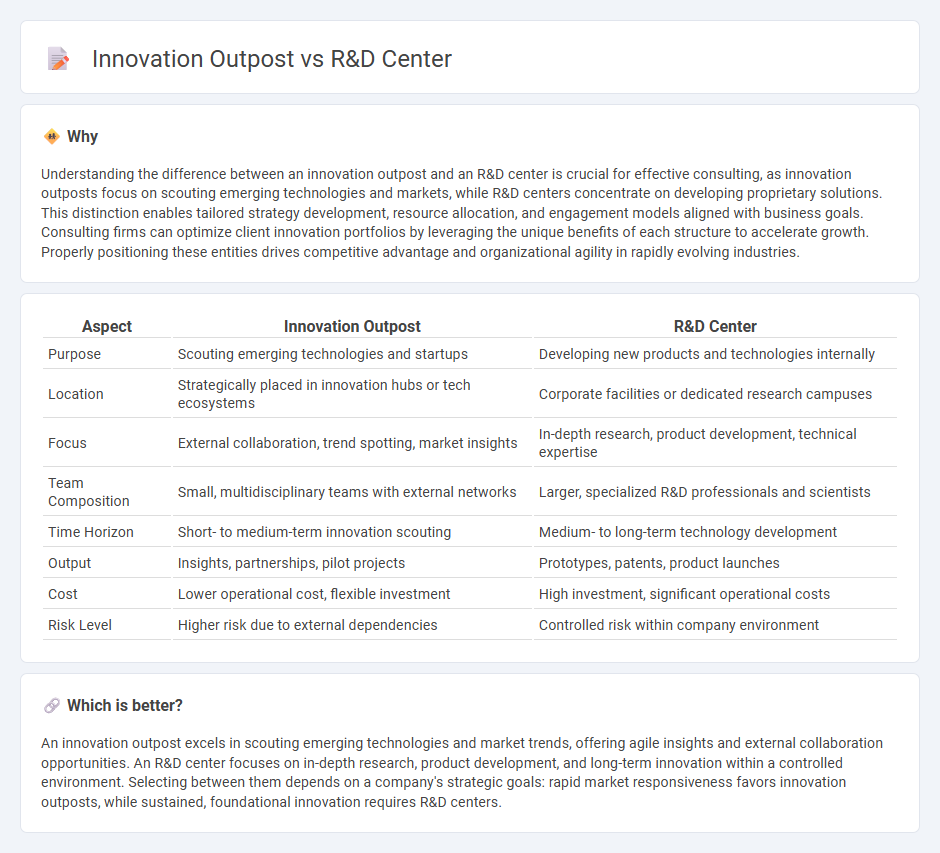
Innovation outposts focus on scouting emerging technologies and startups to accelerate corporate innovation, offering strategic insights and external collaboration opportunities. R&D centers primarily concentrate on in-depth research and product development within a controlled environment, driving long-term technological advancements. Explore how these consulting strategies can transform your organization's innovation pipeline.
Why it is important
Understanding the difference between an innovation outpost and an R&D center is crucial for effective consulting, as innovation outposts focus on scouting emerging technologies and markets, while R&D centers concentrate on developing proprietary solutions. This distinction enables tailored strategy development, resource allocation, and engagement models aligned with business goals. Consulting firms can optimize client innovation portfolios by leveraging the unique benefits of each structure to accelerate growth. Properly positioning these entities drives competitive advantage and organizational agility in rapidly evolving industries.
Comparison Table
| Aspect | Innovation Outpost | R&D Center |
|---|---|---|
| Purpose | Scouting emerging technologies and startups | Developing new products and technologies internally |
| Location | Strategically placed in innovation hubs or tech ecosystems | Corporate facilities or dedicated research campuses |
| Focus | External collaboration, trend spotting, market insights | In-depth research, product development, technical expertise |
| Team Composition | Small, multidisciplinary teams with external networks | Larger, specialized R&D professionals and scientists |
| Time Horizon | Short- to medium-term innovation scouting | Medium- to long-term technology development |
| Output | Insights, partnerships, pilot projects | Prototypes, patents, product launches |
| Cost | Lower operational cost, flexible investment | High investment, significant operational costs |
| Risk Level | Higher risk due to external dependencies | Controlled risk within company environment |
Which is better?
An innovation outpost excels in scouting emerging technologies and market trends, offering agile insights and external collaboration opportunities. An R&D center focuses on in-depth research, product development, and long-term innovation within a controlled environment. Selecting between them depends on a company's strategic goals: rapid market responsiveness favors innovation outposts, while sustained, foundational innovation requires R&D centers.
Connection
Innovation outposts serve as strategic extensions of a company's main R&D centers, enabling early access to emerging technologies and local market insights. These outposts facilitate real-time experimentation and rapid prototyping, accelerating the development cycles within the primary R&D hub. By integrating external innovation ecosystems, companies enhance their competitive edge through continuous knowledge transfer and collaborative problem-solving.
Key Terms
Technology Transfer
An R&D center primarily emphasizes fundamental research and development to create new technologies internally, while an innovation outpost focuses on scouting external innovations and facilitating technology transfer from startups or academic institutions. Technology transfer involves adapting and integrating external innovations into the company's core operations to accelerate product development and market adaptation. Explore how aligning R&D centers and innovation outposts can maximize technology transfer efficiency and competitive advantage.
Strategic Alignment
R&D centers primarily focus on long-term technological advancements aligned with a company's strategic goals, enabling deep research and development capabilities. Innovation outposts serve as localized hubs that monitor market trends and emerging technologies to quickly adapt and inform strategic decisions. Explore the key differences to optimize your organization's innovation strategy effectively.
Open Innovation
R&D centers primarily concentrate on systematic research and development to create new products and technologies within a company's domain, while innovation outposts serve as strategic hubs located in innovation hotspots to scout breakthrough ideas and foster open innovation collaborations with startups, academia, and industry partners. Open Innovation emphasizes leveraging external knowledge and technologies, making innovation outposts crucial for integrating diverse innovation ecosystems and accelerating market-driven solutions. Explore how aligning your innovation strategy with these dynamic models can enhance competitive advantage and drive sustainable growth.
Source and External Links
R&D Centers: What They Are and How They Drive Innovation - An R&D center is an office focusing on computer programming services, often located in offshoring countries to develop unique products or improve existing ones.
R&D Center: Driving Software Innovation and Business - An R&D center is a company branch dedicated to ideation, exploration, experimentation, research, and development of innovative solutions.
R&D Center | Our Business | Samsung US - Samsung Research is an advanced R&D hub leading future technology development through ceaseless innovation and intelligence.
 dowidth.com
dowidth.com